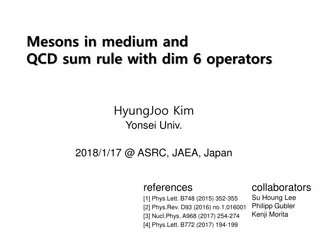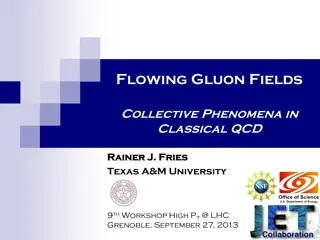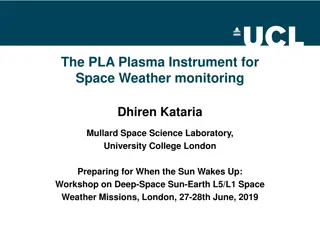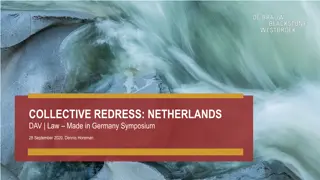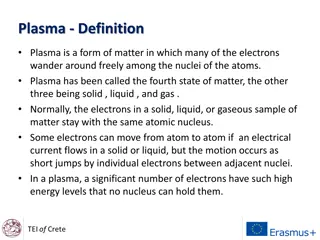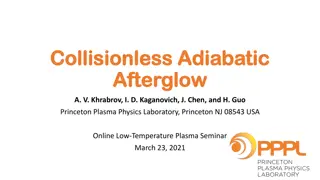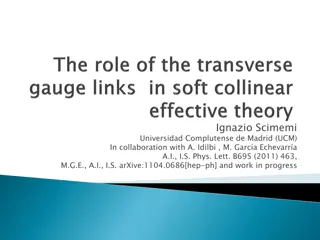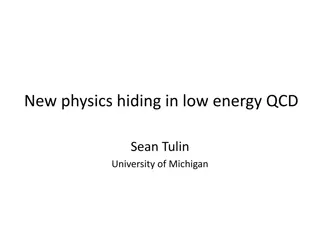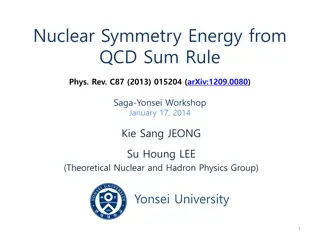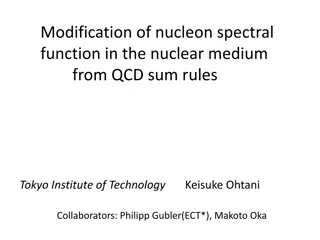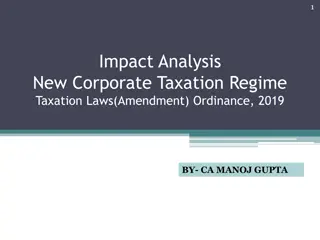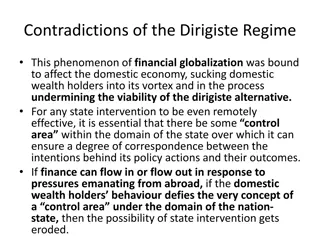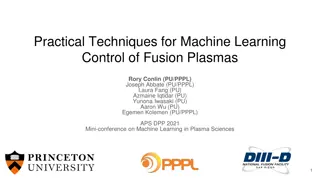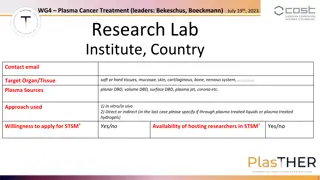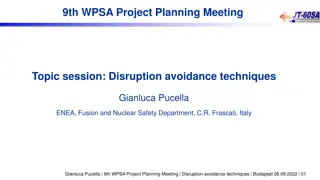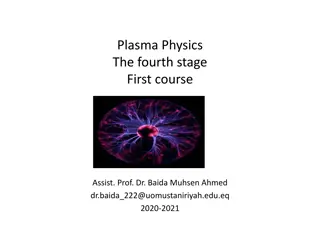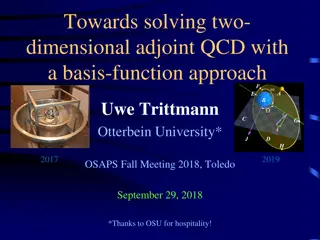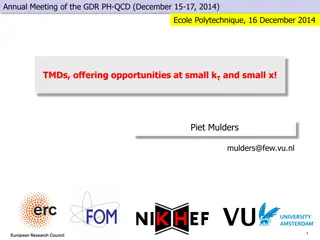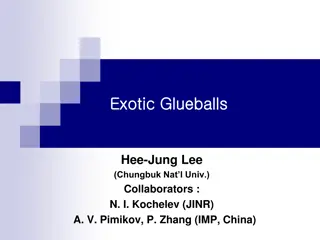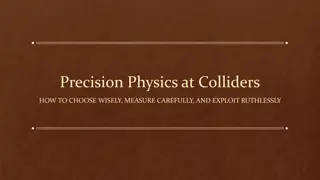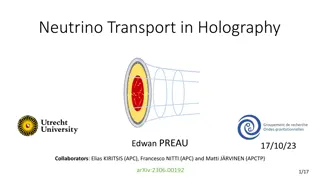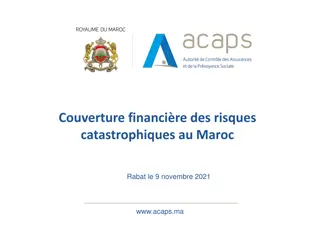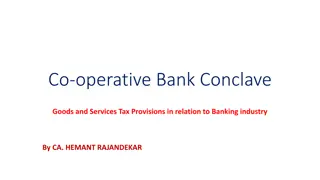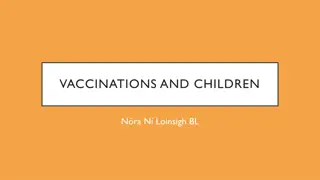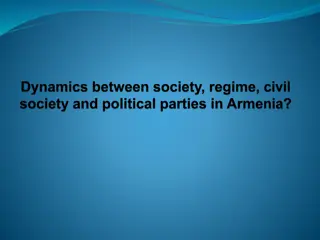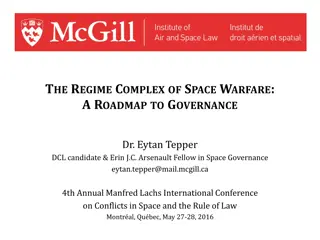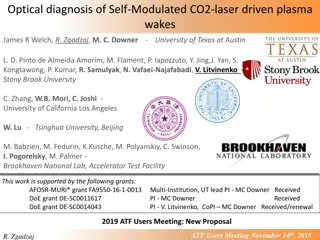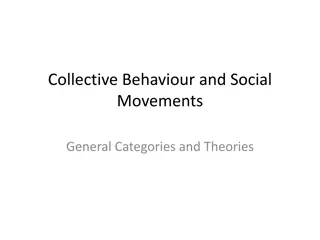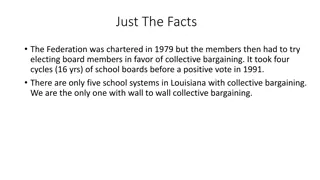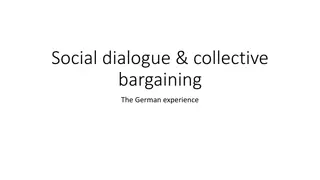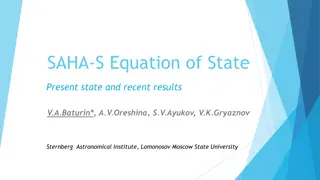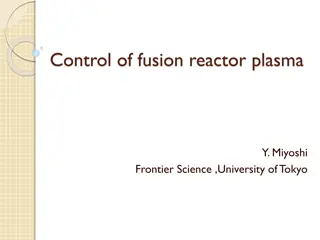Collective Excitations in QCD Plasma: Hydrodynamic Regime Overview
This research presentation by Ali Davody and collaborators from Regensburg University explores collective excitations in QCD plasma, focusing on chiral hydrodynamics, magnetic and vortical waves, hydrodynamic excitation descriptions, and modes derived from kinetic theory. The study delves into the dynamics of equilibrated systems, conservation laws, constitutive relations, ideal and viscous fluid behaviors, and dissipative transport coefficients in non-anomalous fluids.
Download Presentation

Please find below an Image/Link to download the presentation.
The content on the website is provided AS IS for your information and personal use only. It may not be sold, licensed, or shared on other websites without obtaining consent from the author. Download presentation by click this link. If you encounter any issues during the download, it is possible that the publisher has removed the file from their server.
E N D
Presentation Transcript
Collective Excitations in QCD Plasma Ali Davody (Regensburg University) In Collaboration With: Navid Abbasi, Davood Allahbakhshi, Maxim Chernodub, Seyed Farid Taghavi, Farid Taghinavaz
Outline 1. Review of relativistic chiral hydrodynamics 2. Chiral Magnetic wave & Chiral vortical wave 3. Hydrodynamic excitations in chiral hydro 4. Collective modes from kinetic-theory 5. Outlook
Hydrodynamics Hydrodynamics Consider a locally equilibrated system where thermodynamic variables are well-defined in small patches ( ) 1 T Hydrodynamics describes the dynamics of a thermal system slightly deviated from its global thermal equilibrium. Hydrodynamics global-equilibrium locally equilibrated system ( ), x ( ), ( ) T x u x 1 Z + u P N = e hydrodynamic variables = local thermodynamic functions
Effectively only few degrees of freedom matter in Hydro-regime. = + + H H H 0 1 dQ dt = 0, , i H Q i H Q Heisenberg's equation I 0 dQ dt = + ( ) 0, , i H Q i H Q O I Conserved quantities are slowly varying So the non-conserved quantities reach to their equilibrium values faster than conserved quantities The only relevant physical quantities in the hydrodynamic regime are conservedquantities.
Hydrodynamic equations = Conservation laws = T F J J = 0 ( Non-anomalous current ) = J C E B ( Anomalous current ) To solve these equations we need the relations between currents and hydro- variables: Constitutive relations Since Hydro variables are slowly varying functions we may write derivative expansions for currents = + + T T T (0) (1)
Constitutive relations 0 P 0 0 P 0 0 0 P 0 0 0 Ideal fluid = globally boosted of thermodynamic 0 0 0 = + + ( ) T P u u P Ideal fluid = J nu = + + + ( ) T P u u P Viscose fluid First derivative corrections = + J nu
Non-anomalous Fluid In non-anomalous fluids the first order derivative corrections are given by some dissipative transport coefficients = 2 P = + ( ) T T E conductivity Bulk- viscosity Shear- viscosity ??= ????? + u u . u = ( ) P P 2 3 = .u = + P u u
Chiral-Fluid = + + 1 2 1 2 ( ) T J nu T B = B u F B = u u New odd-parity terms related to quantum anomaly anomalous transports s 0 Positivity of entropy production completely fixes anomalous coefficients. 2 3 2 n + n + = + 2 2 (1 ) (1 ), C DT 1 2 D.T.Son and P.Surowka, arXiv:0906.5044 Erdmenger et al. arXiv:0809.2488 Banerjee et al. arXiv:0809.2596 P + P Landau frame 2 n D nT = (1 ) C B + 2 P P 1 1, 12 = , C D = 2 4
Fluid with U(1) U(1) global currents QCD 5 J C E B = Y.Neiman and Y.Oz, arXiv:1011.5107 K.~Landsteiner et al. arXiv:1103.5006 A. V. Sadofyev and M. V. Isachenkov. arXiv:1010.1550 J = 0, = + + = + + , J nu B J n u B B 5 5 5 5 B + + n e n = + 2 2 5 2 ( (3 )) C D T 5 5 p 5 3( ) p e 2 2 e n e n D = + + + 2 2 5 2 2 5 2 ( (3 )) (1 ) C T 5 + 5 p 5 5 5 + 3( ) 2 p + n 1, 6 1 = 5(1 ) D = C = , C B e p 2 2 n e = (1 ) C 5 + 5 p Gauge-gravitational anomaly 5 B Chiral anomaly
Chiral Magnetic Wave Consider a chiral-fluid (zero-chemical potential) in an external magnetic field + = . 0 tn j = C B j Chiral Magnetic Effect 5 Due to CME and CSE Conserved equations are coupled to each other. = C B + = 5 j . 0 tn j Chiral Separation Effect 5 5 Kharzeev, Yee, arXiv:1012.6026 C B + = 0 5 t z 1 C C B = = V B B = n n 2 t 2 2 z ( ) 0 CMW = = 5 2 2 C B 5 + = 0 5 t z Lattice: M ller, Schlichting and Sharma. arXiv:1606.00342 Buividovich and Valgushev, arXiv:1611.05294 susceptibility
Chiral Vortical Wave Rotating Chiral fluid with constant vorticity. C = V CVW In contrast to the CMW, CVW does not propagate at zero vector charge density. Jiang, Huang, Liao. arXiv:1504.03201
Full Spectrum of Chiral Fluid Excitations In all of these studies the CMW and CVW are computed by considering just the fluctuations of vector and axial charge densities. neglecting the energy and momentum fluctuations. This is good approximation in high temperature or density regime. M. Stephanov, H. U. Yee and Y. Yin, Phys. Rev. D 91, no. 12, 125014 (2015). Our Goal: Studding the effects of energy and momentum fluctuations on chiral waves. Finding the full spectrum of chiral fluid excitations. N. Abbasi, D.AllahBakhshi, A.D, F.Taghavi arXiv:1612.08614
Chiral fluid in an External magnetic field The equilibrium state of the system is specified with u = = = (1,0). const. const. T = const. 5 B = const. We choose the hydro variables to be as follows = = = ( , , , ), 1,2,3. 1,2,3,4,5,6. T i a 5 a i = + ( ) e p v In total we have six hydro variables and so six hydro modes i i
Linearizing hydro equations around equilibrium in Fourier space = ( , ) k ( , ) k 0 M ab b This matrix is not block-diagonal in general All fluctuations are coupled to each other. hydrodynamic waves might be a coherent excitation of all hydro-variables Susceptibility matrix
Hydrodynamic Modes Finding the roots of the determinants of the matrix M, perturbatively order by order, in derivative expansion (powers of wave-number k). 2 modes are propagations of T, , 5 Chiral Magnetic-Heat Waves Counterpart of CMW 6 - Modes Sound waves 4 modes are propagations of T, , 5, i Chiral Alfven Waves
Chiral Magnetic-Heat Waves In contrast to zero-chemical potential case, two modes propagates with different velocities.
= 0 Zero chiral chemical potential 5 D. Kharzeev and H.-Y. Yee, 2011 Two modes propagates with the same velocity
Using the free-fermion equation of state = 0 B = 0.5 5 2 T Corrections are small at zero chiral chemical potential
Finite chiral density: we observe a significant difference B = 0.5 2 T At finite chiral density two CMWs propagates with different velocities. each of the fast and slow waves reaches to its maximum velocity when or = 5 or =- 5
Sound-Alfven Waves B = = 1 5 2 T T Sound waves Chiral Alfven waves N. Yamamoto, arXiv:1505.05444 chiral fluid with single chirality Larmore frequency No-anomaly effect
Rotating Chiral Fluid = = const. const. T = const. 5 Equilibrium state = (0, )
Chiral Vortical Heat Waves These two modes carry the perturbations of temperature together with the vector and axial chemical potentials. B = 0.5 2 T 1 2
Sound-Sector No-Anomaly effect in contrast to plasma in magnetic field
Rotating Chiral Fluid Coupled to Magnetic Field Chiral Magnetic Vortical Waves
Mode with plus sign Mode with minus sign
Collective Modes from Chiral Kinetic Theory Kinetic theory is a framework to study the systems including weakly interacting particles under the assumption of rare collisions. All the information of the system is characterized by a distribution function. The dynamics of distribution function is governed by Boltzmann equation. Boltzmann equation equations of motion of the chiral particles D. T. Son and N. Yamamoto. arXiv:1203.2697 M. Stephanov and Y. Yin, arXiv:1207.0747 Berry curvature
Chiral magnetic wave from chiral kinetic theory in high temperature high density plasma M. Stephanov, H. U. Yee and Y. Yin, Phys. Rev. D 91, no. 12, 125014 (2015). Equilibrium distribution function Linearizing Boltzmann equation around the equilibrium N.Abbasi, A.D, F. Taghinavaz, arXiv:
CMW from CKT Comparing with hydro prediction !? The Hydro and Kinetic theory results do not coincide with each other
Chiral Kinetic theory Hydrodynamic in the thermodynamic frame Velocity transformation Hydro Modes are frame dependent!
Non-Linear Modes in Chiral Plasma Shock-Waves B V sh , T , T R R L L Jump Conditions
For special case that VL= VR =0, we have Taub Equations
higher density lower velocity N.Abbasi, M. Chernodub, D. Allahbakhshi, A.D, F. Taghavi: arXiv: .. S.Sen and N.Yamamoto, arXiv:1609.07030 Shock waves in rotating chiral fluid
Conclusion and outlook We have studied the spectrum of conformal - non-dissipative chiral fluid In general there are six hydro-modes. Sound mode mixes with chiral modes. Finding the spectrum with dissipative effects. Taking into account the back-reaction on electromagnetic fields, chiral magneto- hydrodynamics.


